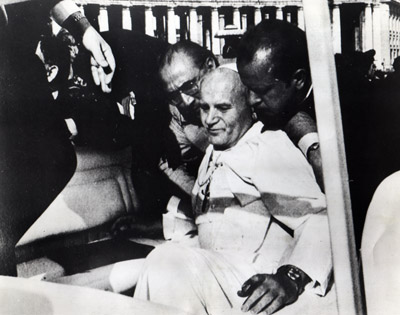
(RNS) Pope John Paul II falls in his popemobile after being shot in the abdomen by Turkish gunman Mehmet Ali Agca on May 13, 1981 in St. Peter’s Square. RNS file photo.
VATICAN CITY (RNS) The Italian left-wing terrorist group the Red Brigades plotted to kidnap Pope John Paul II, according to a new book released Tuesday (Jan. 26) by the Vatican-appointed advocate for John Paul’s canonization.
The book, “Why He Is a Saint,” also reveals that the late pope personally confronted Soviet leader Mikhail Gorbachev about possible Kremlin involvement in the 1981 attempt on the pope’s life.
The book is written by Monsignor Slawomir Oder, the postulator, or official advocate, for John Paul’s sainthood, with Saverio Gaeta, the editor-in-chief of the prominent Italian Catholic magazine Famiglia Cristiana (Christian Family).
The book says the Italian secret services informed John Paul about the Red Brigades plot early in his papacy, and that the pope “wondered about the motivations for the attack.”
Years after Turkish gunman Mehmet Ali Agca shot and nearly killed John Paul in St. Peter’s Square in May 1981, Oder reports, the pope asked Gorbachev about theories that the Kremlin, acting through Bulgarian intermediaries, had been behind the assassination attempt. Gorbachev “said that he had found nothing in the archives of the USSR to support such a hypothesis,” Oder writes.
Oder’s book includes the text of a never-published “open letter” to Agca reiterating the pope’s already announced forgiveness. Agca was released from a Turkish prison last Monday (Jan. 18), saying that he wished to visit John Paul’s tomb at the Vatican.
The book also confirms previous reports that John Paul regularly performed corporal mortification — whipping himself with a belt in order to share in the suffering of Jesus Christ. While still archbishop of Krakow, Poland, he often slept on the bare floor of his room, taking care to unmake the bed in order to hide the fact from his housekeeper.
Yet another previously unpublished document in the book is a 1989 manuscript in which John Paul declared that he would resign the papacy “in case of illness presumed to be incurable and of long duration, that impedes me from adequately exercising the functions of my apostolic ministry, or in case another grave and prolonged impediment similarly poses an obstacle (to that ministry).”
Written when John Paul was 68, the declaration specified that responsibility for putting his resignation “into operation” would lie with senior Vatican cardinals.
John Paul died of natural causes at age 84 in 2005 without ever having put any of those plans into action.
In the declaration, John Paul wrote that he was “following the example” of Pope Paul VI, who in 1965 apparently made similar provisions for his own resignation in case of incapacity.
Oder’s book includes yet another previously unpublished document, from 1994, in which John Paul revealed that he had considered stepping down from the papacy at the standard bishop’s retirement age of 75. John Paul wrote that he had concluded instead that it was his “duty to continue to carry out the job for which Christ the Lord has called me, as long as he, in the mysterious designs of his Providence, will want.”
Oder’s book, which he presented Tuesday in Rome alongside Cardinal Jose Saraiva Martins, former head of the Vatican’s Congregation for the Causes of Saints, is only the latest sign that John Paul’s canonization seems to be a foregone conclusion.
Barely six weeks after John Paul’s death, Pope Benedict XVI waived the usual five-year waiting period for initiating a sainthood cause; last month he signed a decree recognizing John Paul’s “heroic virtues,” making him eligible for beatification, the rank just below sainthood.
Before John Paul can be beatified, Benedict must first recognize a miracle attributed to the late pope’s intercession. He is widely expected to do so at some point this year. A second miracle, occurring after beatification, would be necessary for John Paul’s canonization as a saint.




